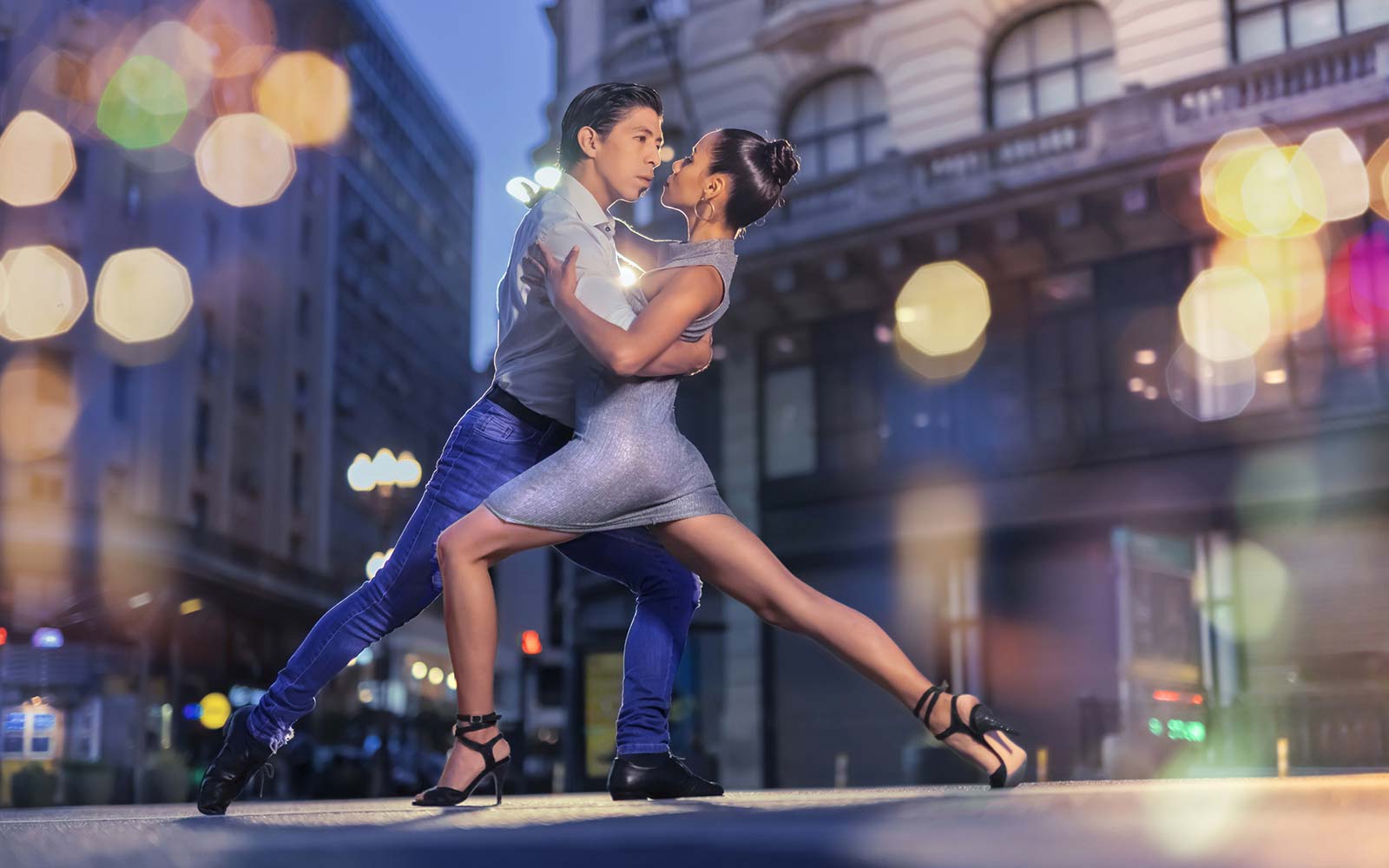People take up ballroom dancing for many reasons. Some people love the energy and artistic excitement of high quality competition style dancing, while others don’t care about that and just want to learn basic dance moves to be competent on a social dance floor. As teachers, we get that and support both goals. But what’s the difference between those extremes?
There are teachers who just work with competitors. In fact, there are even teachers who will only work with championship level competitors. It wouldn’t make much sense in most cases for a world champion to train raw beginners, as the level of knowledge they bring would be lost on someone who doesn’t yet understand the most basic elements of movement. A beginner would feel like they were trying to drink from a fire hose. They would be unable to perform the nuanced details being expressed, or even to grasp what they mean. CBMP? Use of head weight? Integrate musical phrasing with choreography decisions? Yeah, sure.
There are also teachers who only work with social dancers. I know a former social dance studio owner who told me that if someone walked into his studio with no dance experience and wanted a job as an instructor, provided that he or she seemed to have the right attitude and good communication skills, he might give them four hours of training and have them teach the beginner class that same evening. Although this kind of thing makes me raise my eyebrows, I get the reality that to most beginners it wouldn’t necessarily make a difference who teaches them to do the Waltz box step.
Obviously there’s a world of difference between these scenarios! I love teaching beginners, but I also love the thrill of competition and watching dancers improve their skills. I’m passionate about seeing people becoming confident, high quality performers through the process of training and practice. It’s a combined passion that was handed down by my teaching mentor Andy Wong, who ran the Grand Ballroom for 20 years together with his wife Wendy. The two of them taught 18,000 people to dance over 20 years of studio ownership, making the Grand Ballroom Canada’s largest ballroom studio. Andy still competes with his Pro/Am students. Talk to him for five minutes and you can feel the love he has for the competition environment.
I learned to dance first as a competitor, and missed many of the amazing skills of social dancing until years later. At first, I was unable to social dance because I had never really learned how to just put groups of figures together on the fly to accommodate the skill levels of different partners. I had focused so heavily on routines that it took time to learn how to social dance!
What’s the difference in how we learn?
We learn differently at different stages in the process of learning any skill. I used to be a professional driving instructor. We would begin the first lesson by having people understand the multiple steps required even before they start the car. Things like checking the mirrors, the seat position, and putting the foot on the brake. Once they start actually driving, the typical beginner is so focused on looking at the space a few feet in front of the car that they constantly need to adjust the steering wheel, weaving slightly from side to side because their viewpoint is too close rather than out on the horizon. First time drivers have a challenging time even looking to the left and right before entering an intersection. The brain at that point is laser focused on a handful of basic things, leaving no room for more stuff.
It’s the same with dancing. We can’t begin to talk about floor craft or changing choreography on the fly if the person we’re teaching is still focused on whether to use their left foot or their right foot.
So we go through a process. Teachers sometimes even teach incorrect technique because some details can be overwhelming at this early stage. For example, we don’t bother with things like “inside edge of the ball of the foot” with a raw beginner. Just step to the side. Do that on time to the music and we’re happy!
Eventually, as people get confident where to place their feet and what musical beat to do that on, we move beyond that basic action and start to focus on more details. When the brain no longer has to think about those most basic things we can apply other aspects of movement, such as understanding the use of Contra Body Movement. Later on, when those things become ingrained, we move on to even more details such as the use of head weight and pendulum swing, or the nuances of timing. Much later, when a dancer is highly trained, those things also become second nature. But that doesn’t mean they stop learning! Even world champions continue to train, often long after they have retired from competition. They move on to even more nuanced details such as which part of the foot touches the ground at specific points within the beat counts of music.
Social dance training
I’ve had many students tell me that their only goal was to learn sufficient steps to be confident leading or following on a social dance floor. They didn’t care about looking like champions. Naturally, there’s no need to waste time on the most intricate technical details in this case. We leave out a ton of information when teaching for social dancing! We’ll spend our time helping them to know how to adapt step patterns to realities on the floor, to lead with sensitivity and clarity, and to follow even when the lead is unclear.
But that doesn’t mean we abandon technique.
I once had a student tell me that he didn’t want to know any technique at all. He just wanted me to show him where to place his feet. Without any technique, how would that allow you to dance? Ballroom dancing is the art of two people moving in time to music. The goal is to have the partners moving together seamlessly so that it looks like they had the same idea at the same time. Basic technique is essential to make this possible. You can’t move together if both of you have different ideas on when to move the foot, or where your body weight should be on any given step. You can’t be in harmony if the lead is wrenching his partner around by yanking his arms from side to side. Technique is essential.
It’s a question of how much technique we focus on. For social dancing, it isn’t all that important if we “continue to rise on 2 and 3” in the Slow Waltz. Yes, it does look better, and we don’t want to discourage people from learning those technical details. But it’s not nearly as important as other things that will achieve the goals of dancing in a social environment.
Competition training
When I first learned to dance, I wanted to compete. It was my goal, so getting a richer understanding of technical details was important to me. Competition training can be quite different from social dance training. For one thing, we’ll generally work on learning a routine that we can perfect, rather than just teaching groups of figures that we can put together randomly while dancing. Competitors work on perfecting every technical detail, because in competition those things are being judged. If you’re off time in a competition dance, you’re automatically marked last because there’s nothing to judge!
We’ll also spend considerable effort on presentation skills. Being able to move with exceptional confidence and to apply presentation energy while dancing matters for competitors. These are things social dancers can benefit from but have little to do with their dance goals. Competitors will be taught poise and stretch and nuances of posture that are rarely talked about with social dancers. Competitors are taught how to enter the floor, how to connect to each other (even how they connect their hands), and how to bow at the end of the performance. These things are completely unnecessary, perhaps even out of place, for the social dancer.
Technique doesn’t change
Regardless of the dance goals, the actual technique for each dance doesn’t change. What changes is the emphasis we place on details.
If you’re learning to drive, the technique of braking before you enter a curve and accelerating as you start to come out of the curve is no different whether you only drive to the grocery store on weekends, or you are learning to drive a race car. Racing drivers just learn more details of how to time their braking and acceleration actions.
It’s no different with dance. Depending on our goal, the technical details of each dance are exactly the same. You’re just going to learn different aspects of technique. If you are a social dancer, learn how to join multiple step patterns in different orders and focus on nuances of leading and following so that you can be a joy to dance with. If you are interested in discovering the excitement of competition, learn to embrace the finer points of technical details and musicality so that you can stand out in a field of others also working on the same technical precision.
Yet I am reminded of a great message from, of all places, the original Star Trek television series. In one episode entitled “Mirror, Mirror,” Kirk swaps places with his counterpart in a savage alternate universe. Mr. Spock comments at the end, “It was far easier for you, as civilized men, to behave like barbarians than it was for them as barbarians to behave like civilized men.” Relating this concept for dancers means that those who can apply good technique because of competition-style training will naturally find it much easier to learn social dance skills than it is for long-time social dancers to learn technical details. For that reason, I like to teach as much technique as I can given the experience of each student.
The most important thing is to dance. It’s good for the body, the mind, and the soul.














